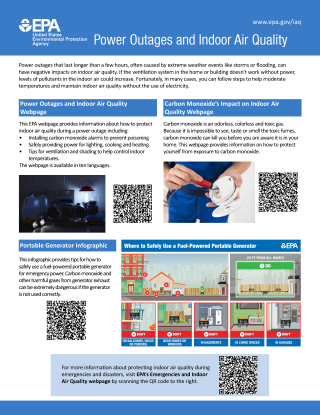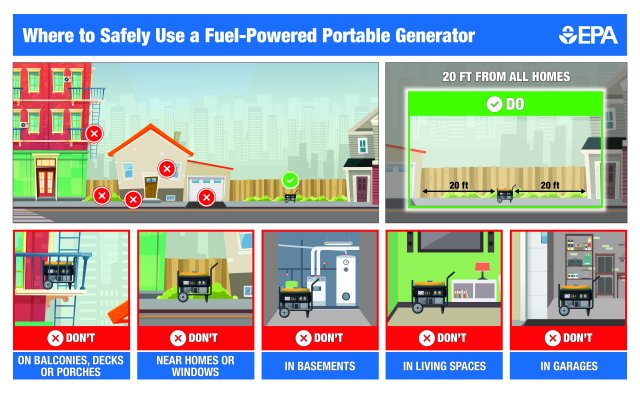Power Outages and Indoor Air Quality (IAQ)

Residences and other buildings in the U.S. are usually designed and built to maintain comfortable and healthy indoor environments, regardless of what the weather is like outside. In most cases, electrical power is relied on to help keep indoor conditions comfortable. Power outages that last longer than a few hours, often caused by extreme weather events, like storms or flooding, can have negative impacts on indoor environments. For example, without electricity, controlling the temperature indoors may be difficult or impossible, and if the ventilation system in the home or building doesn't work without power, levels of pollutants in the indoor air could increase. However, in many cases, some steps can be taken to help moderate temperatures and maintain indoor air quality without the use of electricity.
On this page:
- Install Carbon Monoxide (CO) Alarms to Prevent CO Poisoning
- Safely Provide Power for Lighting, Cooking and Heating
- Ventilation and Shading Can Help Control Indoor Temperatures
- Additional Resources
On other pages:
- Emergencies and IAQ
- Flood Cleanup to Protect Indoor Air and Your Health
- Resources for Flood Cleanup and Indoor Air Quality
- Wildfires and Indoor Air Quality (IAQ)
- Create a Clean Room to Protect Indoor Air Quality During a Wildfire
- Homeland Security and the Indoor Environment
- Natural Disasters
Install Carbon Monoxide (CO) Alarms to Prevent CO Poisoning
Carbon monoxide (CO), which is an invisible and odorless gas, can come from a variety of combustion appliances, like gas stoves, ovens or barbeque grills. CO can build up quickly indoors and can linger for hours. At elevated levels, CO can quickly cause significant harm and even death. Make sure that your home is equipped with CO alarm(s), and that the alarm(s) are functioning properly when installed and have a digital display and battery backup function. Check or replace the battery when you change the time on your clock each spring and fall. The U.S. Consumer Product Safety Commission (CPSC) recommends that every home have CO alarms on each level outside each sleeping area. CO alarms are available at most hardware stores.
Learn about Carbon Monoxide's Impact on Indoor Air Quality
Safely Provide Power for Lighting, Cooking and Heating

Portable Generators (Powered by fuel): During power outages, portable generators can be used to help temporarily restore power to a few key appliances such as refrigerators, lights and fans. Most portable generators are powered by fuels such as gasoline, natural gas or kerosene. If they are not used correctly, these generators can be hazardous because they give off toxic fumes. (Portable generators that are powered by batteries or solar power stations are now available and these will not give off fumes.)
- Do use portable generators outside and far away from buildings.
- Do not use portable generators under any of the following conditions:
- inside your house or garage
- on balconies or near doors, vents or windows, and
- near where you or your children are sleeping.
Portable Generators Powered by Batteries or Solar Power Stations: Battery powered generators or power stations are becoming more widely available. Some of them can be connected to solar panels for recharging. They can be a practical choice to power small appliances, lights and fans during a power outage. They are often less powerful than traditional gas-powered generators; however, they do not generate toxic fumes, and so they can be used in indoor spaces, on balconies, or near doors, vents, and windows.
Heating:
Combustion Appliances: During a power outage, do not try to heat your home by using combustion appliances including gas stoves or ovens, barbeque grills or dryers. Never operate any gas-burning heater or other appliance in a poorly vented or closed room, or where you are sleeping.
Fireplaces: Follow these safety precautions if using a vented fireplace for heating
- Have flues and chimneys inspected before each heating season for leakage and blockage by creosote or debris.
- Open the fireplace damper before lighting the fire and keep it open until the ashes are cool. Never close the damper or go to bed if the ashes are still warm. An open damper may help prevent build-up of poisonous gases inside the home.
- Never use gasoline, charcoal lighter fluid or other fuel to light or relight a fire because the vapors can explode. Never keep flammable fuels or materials near a fire. Never store flammable liquids in your home.
- Never use charcoal in a fireplace because there is a risk of carbon monoxide poisoning.
- Keep a screen or glass enclosure around a fireplace to prevent sparks or embers from igniting flammable materials.
- Burn only dry, seasoned wood and maintain a hot fire.
- Learn more about Burn Wise for cleaner-burning fires and what you can do to keep you and your family safe.
Vehicles: Do not run a car or truck inside a garage attached to your house, even if you leave the door open.
Cooking: Do not use unvented combustion appliances indoors such as barbecues, hibachis, or camp stoves. Unvented combustion appliances should not be used to cook indoors, or for any other indoor use. Combustion appliances produce toxic fumes, including carbon monoxide (CO). Vented appliances can be used to safely cook indoors during a power outage if the vent does not require power to operate. You can use a vented fireplace or a vented wood stove or another vented fuel burning stove, if it is set up for cooking. When using cooking appliances outdoors, like camp stoves and barbecues, do so at a safe distance away from your home’s doors, windows and any air intakes for your home’s HVAC system.
Lighting: Use flashlights or battery powered lanterns if available. If you use candles, make sure the area is ventilated since candles emit combustion products and, if left unattended, can be a fire hazard. If available, use flashlights or battery powered lanterns instead of candles.
Ventilation and Shading Can Help Control Indoor Temperatures

Open and close windows and use window coverings such as drapes, shades and awnings to help moderate indoor air temperature. When windows are open, screens may be used to prevent pests from entering the home. Keep in mind that the security of your home may also be a consideration when windows are open.

In Warm or Hot Conditions:
During the day in warm or hot conditions, cover windows that receive morning and afternoon sun with shades to help limit a rise in indoor temperatures. You can use drapes, shades, roller shades, awnings, or louvers to cover your windows. Outdoor awnings and louvers can reduce the heat that enters a home more than indoor shades. In general, if the air outside is hotter than the air inside, close the windows. If the air outside is cooler, open the shades or drapes, and the windows.
In Cool or Cold Conditions:
Open drapes and window shades during the day to help warm the indoor air and close them at night to help retain the heat. In general, leave the windows closed if the air outside is colder than the air inside.

Indoor Air and Ventilation in Extreme Temperature Situations:
Although keeping windows and doors closed may help maintain temperatures, in some cases it may be necessary to open the windows slightly to maintain adequate ventilation. Providing adequate ventilation can be especially important while cooking and during other activities that may reduce air quality indoors. Note that there is always some amount of ventilation occurring indoors. Some amount of air movement or infiltration (passive ventilation) occurs naturally, as air passes through small openings or cracks, such as those around windows and doors. However, it may not be enough to maintain adequate ventilation in extreme temperature situations. When extreme temperature situations are accompanied by high outdoor air pollution, including from Wildfires, Volcanic Eruptions, and Dust Storms it may also be important to reduce natural ventilation to keep pollutants out. Learn more about maintaining indoor air quality during Extreme Heat events.
Additional Resources
- Carbon Monoxide's Impact on Indoor Air Quality
- Sources of Combustion Products
- Flood Cleanup and the Air in Your Home booklet (with illustrations of how and where to use portable generators)
- Homeowner’s and Renter’s Guide to Mold Cleanup after Disasters (with portable generator safety tips)
- Ready.gov - Power Outages
- CDC - Carbon Monoxide Poisoning FAQs
- CPSC - Generators & Engine-Driven Tools (includes Portable Generators)


